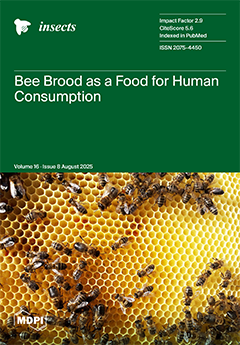(1) Background:
Tolypocladium spp. are fungi known for producing cyclosporin A and their ability to infect insects. However, their pathogenicity against the lepidopteran pest
Plutella xylostella has not been previously reported. (2) Methods: Four
Tolypocladium strains were isolated from soil and identified through morphological and phylogenetic analyses (ITS, gene sequencing). Growth rates, sporulation capacity, and stress tolerance (45 °C heat, UV) were evaluated. Pathogenicity was assessed via larval bioassays, and immune responses were analyzed by quantifying Toll pathway gene expression and enzyme activities (PO, CAT, POD, GSTs, CarE, AChE) from 24 to 96 h post-inoculation. (3) Results: Strains N8-SF-04092 and O1/O2/O3-SF-04630/04927/04931 were identified as
Tolypocladium cylindrosporum and
Tolypocladium inflatum, respectively. Strain O2 showed the highest growth rate (
p < 0.05), while O3 and N8 exhibited superior sporulation (>7 × 10
5 spores/mm
2). N8 also demonstrated notable thermotolerance. In pathogenicity assays, O1, O3, and N8 caused 98.3%, 93.3%, and 96.7% larval mortality, respectively, with LT
50 values (3.89–4.45 days) significantly lower than O2 (
p < 0.05). Immune gene expression in
P. xylostella was transiently activated at 24 h but suppressed from 48 to 96 h by N8 (
p < 0.05), while O1 induced partial activation at 24 h and 96 h but suppression at 48 h and 72 h. Protective enzymes (PO, CAT) were initially upregulated (24–48 h) but inhibited after 72 h (
p < 0.01). POD activity showed opposing trends between O1 (initially activated then suppressed) and N8 (initially suppressed then activated). Detoxification enzymes (GSTs, CarE, AchE) were predominantly suppressed, except for GSTs, which increased at 72–96 h. (4) Conclusions: Strains O1 and N8 exhibit high virulence against
P. xylostella by disrupting immune responses through dynamic modulation of Toll pathway genes and enzyme activities. The thermotolerance of strain N8 further enhances its promising biocontrol agent for field application.
Full article






